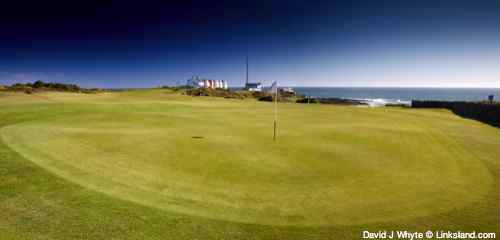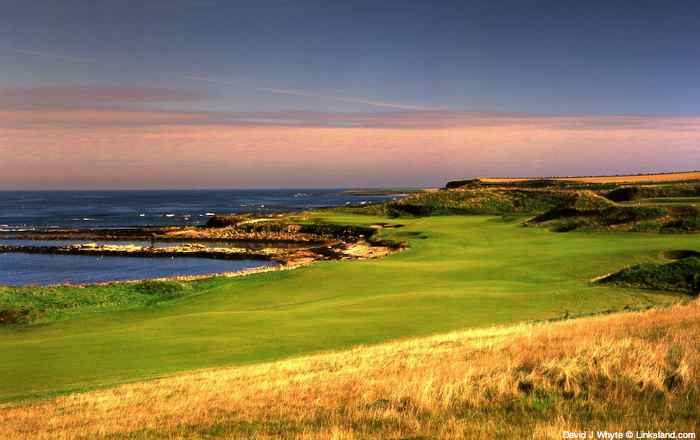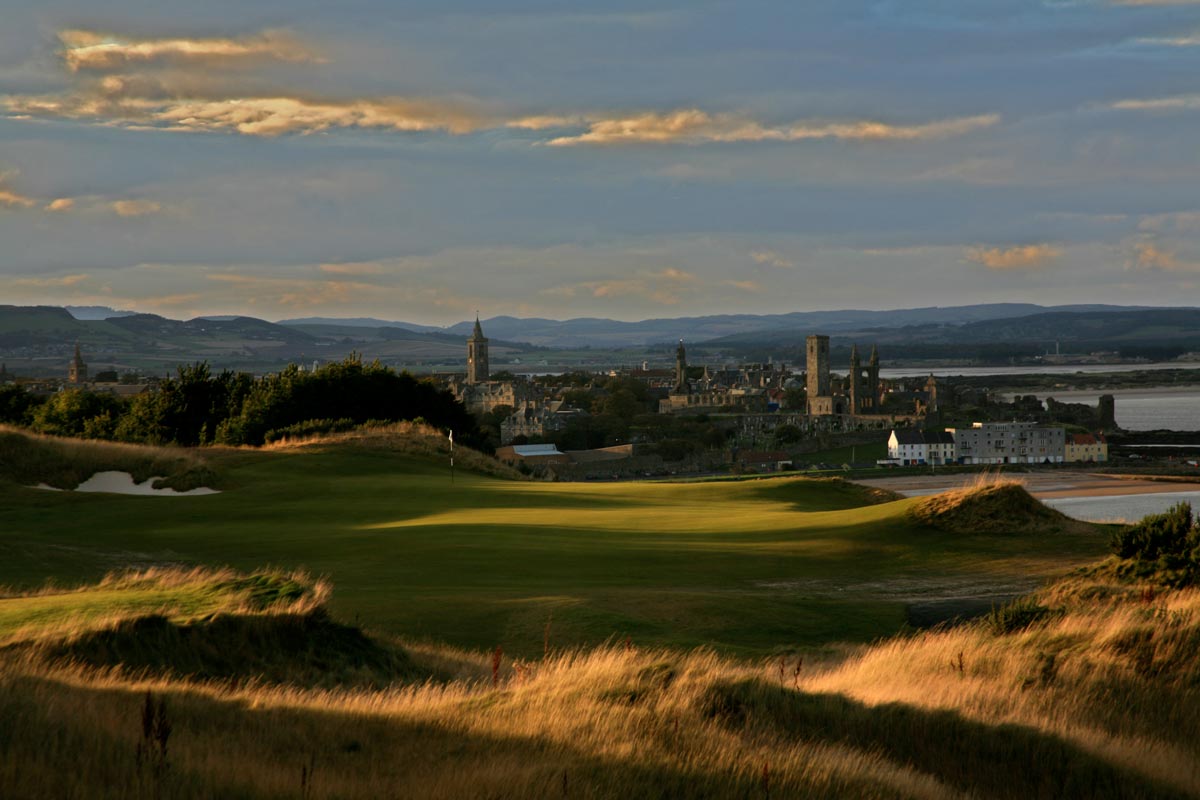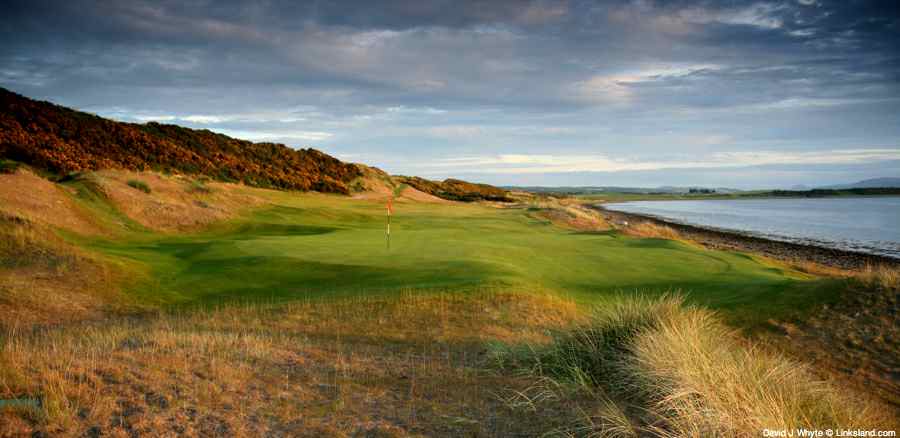SCOTTISH GOLF RENAISSANCE
David J Whyte reflects on the renaissance that has taken place in the Home of Golf over the past decade.
Finding a site for a new golf course anywhere on Scotland’s coast must be like finding a golf ball in the middle of a thick gorse bush. Surely over the past 600 years of development of the game on its home patch, any likely location has long been occupied.
It appears not so! Over the past decade a number of new developments have sprung up, both coastal links and inland. Before the recession planning applications for golf course developments were falling like wedding confetti on the desks of Scotland’s Local Council planning offices, mostly from cash-rich Americans looking to make their mark in the land where the game began. This was an invasion almost tantamount to that of the Vikings a thousand years before! Scotland’s east coast, once a’feared at the sight of a longboat on the horizon, was now being set upon by private jet or helicopter.
The Quiet Revolution
This current trend kicked off back in the 90’s when money wasn’t just a distant memory. On behalf of Crail Golfing Society, the 7th oldest club in existence, Pennsylvanian Gil Hanse was asked to build the Craighead course. The club’s existing Balcomie Links had been created by Old Tom Morris more than 100 years before, fashioned simply from the ready, rippling linksland and with only a wheel barrow, a couple of shovels and the occasional helper.
The new Craighead was a bit more of a challenge, a links course to be ‘materialised’ from a headland that was once the undistinguished domain of beef cattle and barley. Hanse jumped at the opportunity! The result was not an unmitigated success! Criticised mainly for its over-exuberant bunkering and perilous rough, Craighead got off to a bumpy start (I had the pleasure of playing it recently and must add it has been improved greatly).
Emboldened by Crail’s effort, America-based pharmaceutical billionaire, (inventor of the nicotine patch), race-team sponsor, vineyard owner and resort developer, Dr. Donald Panoz and his wife Nancy set about creating an opulent palace overlooking the grey seal & eider duck infested waters of St Andrews Bay. The St Andrews Bay Golf Resort & Spa proffered a gargantuan hotel along with two 18-hole courses, again built on upper-level headland with nary a natural sand dune to be seen. For its first few years St Andrews Bay fell short of the good doctor’s dream and has only recently, after much modification under the Fairmont flag been accepted into the Scottish golfing scene.
Storming Kingsbarns
Around the same time, another project was emerging from the ‘haar’ (Scots mist) about 6 miles south of the ‘Auld Grey Toon’. Surprisingly, with such seeming fad for creating ‘faux’ links, this was a links that actually played down to the sea. Kingsbarns Links was created by two Californians, Art Dunkley and Mark Parsinen who moved heaven and huge amounts of earth to create their Rubenesque interpretation of a proper Scottish coastal course. Using state-of-the-art ground-shaping equipment, they sculpted this once pedestrian pastureland into a flowing tapestry of links holes, a makeover that was little short of miraculous.
Then, as if crafting a visionary links course from indifferent farmland wasn’t enough, they did the unthinkable! They set their green fee above that of the Old Course at £125.00 a round (A.D. 2000) while the Old Course was only asking £90. The ‘Auld Grey Toon’ worthies were black-affronted (Scots for highly offended). But Parsinen and Dunkley knew what they were doing, knew they had a unique product and most of all knew their market, mainly affluent, fellow Americans on a pilgrimage to play the venerable Scottish links. Within a year of being opened, Kingsbarns was an unmitigated success. You were hard-pressed to secure a tee time! There was clearly gold in them there sandhills - even if they had to be manufactured!
Keepers of the Castle
St Andrews Links Trust, long-time keepers of the Old Course and traditionally a sleepy sub-section of the local town council, saw the success of Kingsbarns and decided to get its commercial act together. They flew in Scots born architect David McLay Kidd, who was doing big things in Oregon, to create The Castle, St Andrews’ 7th course. At the same time on Scotland’s west coast, Kyle Philips had created Dundonald Links and McLay Kidd was moulding Machrihanish Dunes. There were planning applications for a new Jack Nicklaus course near Aberdeen, a Paul Lawrie course also in the Aberdeen area and back on the west near the town of Irvine, ‘The Ayrshire’ was being conceived. The floodgates had opened. Scotland hadn’t seen such a welter of golf course construction since the early 1900’s when literally hundreds of new golf courses appeared.
A Trump Card
Donald Trump, that flip-topped American property billionaire had to get in on the action. As is his style he was causing ructions and public protests just north of the city of Aberdeen with his proposal for the ‘best golf course in the world’, a £750 million megalith resort consisting of 5-star hotel, housing estates and time-share units - as well as two 18-hole courses covering one of the finest stretches of pure duneland in the country. There is still fierce debate on all sides of the fence whether a luxury Trump enclave will in actual fact add to the sum of Scottish golf. Until it’s up and open we shall have to wait and see. Ground has now been broken!
Castle Stuart Golf Links
Almost unnoticed in a quieter corner of the country, between Nairn & Inverness, Mark Parsinen, the other half of the Kingsbarns’ success story had found a stretch of land overlooking the Moray Firth towards the Black Isle. Creating a sequel to Kingsbarns wasn’t going to be easy but Parsinen is a man of unusual vision.
After 5 years in the making, the resulting Castle Stuart Golf Links has just closed for the winter, finishing its first full season to great acclaim. Co-designed by Parsinen and Gil Hanse, the American who had a significant hand in this current course building renaissance, the track covers an extraordinary combination of topography ranging from sandy seashore to raised headland with banks of gorse separating the two. Liberal amounts of sand has been pushed, moulded and cajoled into this multiform landscape to create a seamless, seemingly innate golfing terrain.
Does it work? Has Parsinen done it again? Stepping onto the golf course you are immediately struck with visual exuberance. From the clubhouse and its high promontory it’s difficult to decide which way to look, there are so many striking golf landscapes to behold. The opening holes on both the front and back subtly swoop, swoon and rise again towards their respective greens always with a backdrop of the Moray Firth and the surrounding mountains along with the Kessock Bridge and Fort George protruding out into the Firth. It is certainly a visual delight in every direction.
Does it play as well as it looks? More on that imminently. Before venturing onto the course, it’s worth understanding the philosophy behind Castle Stuart’s construction. Courses of recent decades in many instances have been built to host tournament events and therefore are designed with the abilities of top tour players in mind. Mark Parsinen is himself a passionate golfer but like the majority of us, I’m sure he doesn’t mind me saying, does not possess God-like golfing gifts; they were dished out to an infinitesimal proportion of people on this planet. So why build a golf course for such a small minority? And why neglect the needs of your most valued customers – golfers just like you and I?
The result is a course that, besides stirring the heart with its grand views, sets out to treat the golfer as its honoured guest. Schmaltzy as that may sound, that’s the best way I can put it! While you might leak a little left off the tee or pull your approach shot away from its intended, the course never sets out to embarrass you or leave you lost without a shot to play. It has a generous disposition and that, I have gleaned during several conversations with Mark P and his veteran team is very much what was desired.
You might not think that looking down the narrow runway of the 1st with the Moray Firth hard on your right and an impregnable bank of thorny gorse on the left. But in practice it’s not so daunting. The gorse has been cut back and the fairway banked to gather the ball into safe territory. You soon realise Castle Stuart is there to be enjoyed, not endured.
At the 4th you turn towards Castle Stuart itself, a regal 17th century citadel perched on a knoll as if to appreciate the golf course and not the other way around. The remaining front half climbs onto the higher level offering a stratagem of holes and vistas.
The term ‘infinity greens’ was new to me until I visited Castle Stuart. ‘Infinity pools’ I’d heard of - usually in upmarket spas overlooking the Indian Ocean. It’s the higher level holes such as the 7th and 16th that capitalise on this feature and Mark and his team have made the most of it, creating putting surfaces seemingly etched on the edge of outer space. Sending a well-struck approach shot towards such a target with no visible means of stopping the ball can cause a certain tingling sensation in the nether regions.
The greens are another story! If you fail to hit & hold them, which is easily done, getting up and down is almost as exciting as plying a perfect iron shot straight up to the pin. There’s thought and excitement built into every corner & crevice of this course with an attention to detail that is quite remarkable. It seems that every scenario has been considered and set up to give the golfer an exciting round.
The back nine mirrors the front in that it plays along the foreshore for three holes before turning up and in. There are no two holes the same or even similar so you are indulged to a new surprise on every occasion. My favourite for playing purposes is the 13th, a hole that might have been less interesting being furthest from the shore and airy prospects. It doglegs away from a natural sandy cleft inhabited by swooping sand martins and rises to a burly, undulating green perched on a high point that overlooks the closing holes with one of the best views of the course and its surrounds. The 18th is also to be savoured, a gradually descending Par 5 where you are encouraged to ‘give it your all’ but reaching the green in two is far from easy especially into a prevailing westerly wind.
Getting back to the clubhouse, the art deco design calls attention to the views once again from each of its three floors. The second floor locker rooms have added, as well as a wrap-around balcony, a ‘loo with a view’ looking over the 9th. The third floor comprises a lounge and dining area with balcony. There are plans to include a small 7-bedroom luxury hotel & spa along with ‘resort-ownership’ lodges & apartments and in the fullness of time, a second 18-hole seaside course.
Now reasonably familiar with the place, I believe Castle Stuart has set a new benchmark in the Home of Golf, which will no doubt have a knock-on effect on golf course construction the world over. Parsinen is a known lover of links courses especially the Old Course in St Andrews. At Castle Stuart he has blended links characteristics with modern aesthetics to construct a golf experience that is at the same time thrilling and inspiring. But most of all, he has shown that it possible to create a contemporary world-class golf course that makes the average golfer feel good as well as tasking better players to present their very best game. Of course, you pay for the privilege. A round at Castle Stuart costs £150. Life-enhancing experiences don’t often come cheap.
Oh, and just one more thing regarding Mr Trump creating ‘the greatest golf course in the world’. He’s maybe too late!
Contact Details
Castle Stuart Golf Links Balnaglack Farmhouse Inverness IV2 7JL Scotland T: +44 (0)1463 796111 E: bookings@castlestuartgolf.com W: www.castlestuartgolf.com Fees: Weekdays & Weekends – £150 per round 36 Hole Ticket - £225 - playable by the same golfer over any consecutive 4-day period Caddies Caddy Fee - £35 plus discretionary gratuity. Caddies should be requested in advance through the reservations department and are subject to availability. Club Hire - £30 per roundWhere Else to Play
The Royal Dornoch Golf Club Golf Road, Dornoch, Sutherland, IV25 3LW T: 01862 810 219 E: rdgc@royaldornoch.com www.royaldornoch.com The Nairn Golf Club Seabank Road, Nairn, IV12 4HB T: 01667 453 208 E: bookings@nairngolfclub.co.uk www.nairngolfclub.co.uk
Where to Stay
Royal Golf Hotel First Tee, Dornoch, Sutherland, IV25 3LG T: +44 (0)1463 796 111 E: bookings@castlestuartgolf.com www.royalgolfhoteldornoch.co.ukGolf View Hotel & Spa The Seafront, 63 Seabank Road, Nairn, IV12 4HD T: +44 (0)1667 452 301 E: golfview@crerarhotels.com. www.crerarhotels.com





